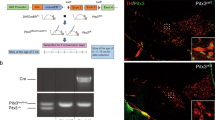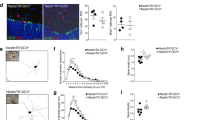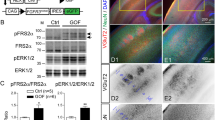Abstract
Transforming growth factor (TGF)-α is neurotrophic for midbrain dopaminergic neurons in vitro. Here I investigated whether a null mutation in the TGF-α gene affects the normal development or survival of dopaminergic neurons in either the substantial nigra (SN) or the ventral tegmental area (VTA). The SN of TGF-α knockout mice contained 50% fewer dopaminergic neurons than the control SN, but VTA neuron number was unchanged. In addition, the overall volume of the dorsal striatum was reduced by 20%. Newborn mice showed a similar decrease in the number of SN dopaminergic neurons, suggesting that TGF-α is unlikely to regulate developmental neuron death. These studies indicate that TGF-α is required for the normal proliferation or differentiation of a select population of dopaminergic neurons within the SN.
This is a preview of subscription content, access via your institution
Access options
Subscribe to this journal
Receive 12 print issues and online access
$209.00 per year
only $17.42 per issue
Buy this article
- Purchase on Springer Link
- Instant access to full article PDF
Prices may be subject to local taxes which are calculated during checkout



Similar content being viewed by others
References
Ernfors, P., Lee, K.-F. & Jaenisch, R. Mice lacking brain-derived neurotrophic factor develop with sensory deficits. Nature 368, 147–150 (1994).
Jones, K. R., Fariñas, I., Backus, C. & Reichardt, L. F. Targeted disruption of the BDNF gene perturbs brain and sensory neuron development but not motor neuron development. Cell 76, 989–999 (1994).
Moore, M. W. et al. Renal and neuronal abnormalities in mice lacking GDNF. Nature 382, 76–79 (1996).
Sánchez, M. P., Silos-Santiago, I., Frisén, J., Lira, S. A. & Barbacid, M. Renal agenesis and the absence of enteric neurons in mice lacking GDNF. Nature 382, 70–73 (1996).
Pichel, J. G. et al. Defects in enteric innervation and kidney development in mice lacking GDNF. Nature 382, 73–76 (1996).
Luetteke, N. C. et al. TGF-α deficiency results in hair follicle and eye abnormalities in targeted and waved-1 mice. Cell 73, 263–278 (1993).
Mann, G. B. et al. Mice with a null mutation of the TGF-α gene have abnormal skin architecture, wavy hair and curly whiskers and often develop corneal inflammation. Cell 73, 249–261 (1993).
West, M. J. & Gundersen, H. J. G. Unbiased stereological estimation of the number of neurons in the human hippocampus. J. Comp. Neurol. 296, 1–22 (1990).
West, M. J. New stereological methods for counting neurons. Neurobiol. Aging 14, 275–285 (1993).
Lieb, K. et al. Pre- and postnatal development of dopaminergic neuron numbers in the male and female mouse midbrain. Dev. Brain Res. 94, 37–43 (1996).
Graybiel, A. M., Ohta, K. & Roffler-Tarlov, S. Patterns of cell and fiber vulnerability in the mesostriatal system of the mutant mouse weaver. I. Gradients and compartments. J. Neurosci. 10, 720–733 (1990).
Gundersen, H. J. G. et al. The new stereological tools: Disector, Fractionator, Nucleator and point sampled intercepts and their use in pathological research and diagnosis. Acta Pathol. Microbiol. Immunol. Scand. 96, 857–881 (1988).
Bayer, S. A. Neurogenesis in the rat neostriatum. Int. J. Dev. Neurosci. 2, 163–175 (1984).
van der Kooy, D. & Fishell, G. Neuronal birthdate underlies the development of striatal compartments. Brain Res. 401, 155–161 (1987).
Schambra, U. B. et al. Ontogeny of D1A and D2 dopamine receptor subtypes in rat brain using in situ hybridization and receptor binding. Neuroscience 62, 65–85 (1994).
Weickert, C. S. & Blum, M. Striatal TGF-α: Postnatal developmental expression and evidence for a role in the proliferation of subependymal cells. Dev. Brain Res. 86, 203–216 (1995).
Seroogy, K. B., Gall, C. M., Lee, D. C. & Kornblum, H. I. Proliferative zones of postnatal rat brain express epidermal growth factor receptor mRNA. Brain Res. 670, 157–164 (1995).
Kornblum, H. I. et al. Prenatal ontogeny of the epidermal growth factor receptor and its ligand, transforming growth factor alpha, in the rat brain. J. Comp. Neurol. 380, 243–261 (1997).
Kuhn, H. G., Winkler, J., Kempermann, G., Thal, L. J. & Gage, F. H. Epidermal growth factor and fibroblast growth factor-2 have different effects on neural progenitors in the adult rat brain. J. Neurosci. 17, 5820–5829 (1997).
Kornblum, H. I., Gall, C. M., Sergoogy, K. B. & Lauterborn, J. C. A subpopulation of striatal GABAergic neurons expresses the epidermal growth factor receptor. Neuroscience 69, 1025–1029 (1995).
Oo, T. F. & Burke, R. E. The time course of developmental cell death in phenotypically defined dopaminergic neurons of the substantia nigra. Dev. Brain Res. 98, 191–196 (1997).
Bayer, S. A. et al. Selective vulnerability of late-generated dopaminergic neurons of the substantia nigra in weaver mutant mice. Proc. Natl Acad. Sci. USA 92, 9137–9140 (1995).
Mytilineou, C., Park, T. & Shen, J. Epidermal growth factor-induced survival and proliferation of neuronal precursor cells from embryonic rat mesencephalon. Neurosci. Lett. 135, 62–66 (1992).
Bouvier, M. M. & Mytilineou, C. Basic fibroblast growth factor increases division and delays differentiation of dopamine precursors in vitro. J. Neurosci. 15, 7141–7149 (1995).
Bloom, F. E., Young, W. G., Nimchinsky, E. A., Hof, P. R. & Morrison, J. H. in Neuroinformatics - An Overview of the Human Brain Project (eds Koslow, S. H. & Huerta, M. F.) 83–123 (Lawrence Erlbaum, Mahwah, 1997).
Acknowledgements
I would like to thank John Morrison and members of his laboratory for support and discussions concerning the stereological methods used in this study, Peter Rapp for comments on the manuscript, and Susan Lasky and Jeremy Kay for technical support. This work was supported by NIH grant AG08538.
Author information
Authors and Affiliations
Corresponding author
Rights and permissions
About this article
Cite this article
Blum, M. A null mutation in TGF-α leads to a reduction in midbrain dopaminergic neurons in the substantia nigra. Nat Neurosci 1, 374–377 (1998). https://doi.org/10.1038/1584
Received:
Accepted:
Issue Date:
DOI: https://doi.org/10.1038/1584
This article is cited by
-
Nolz1 expression is required in dopaminergic axon guidance and striatal innervation
Nature Communications (2020)
-
Canonical BMP–Smad Signalling Promotes Neurite Growth in Rat Midbrain Dopaminergic Neurons
NeuroMolecular Medicine (2014)
-
Molecular mechanisms of dopaminergic subset specification: fundamental aspects and clinical perspectives
Cellular and Molecular Life Sciences (2014)
-
Tunneling-nanotube development in astrocytes depends on p53 activation
Cell Death & Differentiation (2011)
-
Elevated P75NTR expression causes death of engrailed-deficient midbrain dopaminergic neurons by Erk1/2 suppression
Neural Development (2009)



